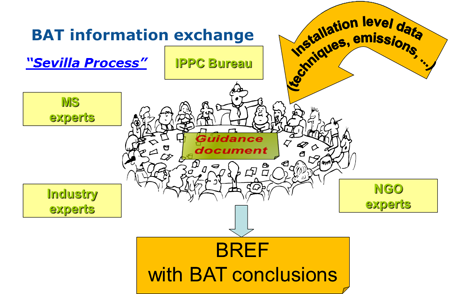IED Principles
BAT reference documents and exchange of information
This work is coordinated by the European IPPC Bureau of the Institute for Prospective Technology Studies at the EU Joint Research Centre in Seville (Spain). Until the adoption of such new BAT conclusions, the old BAT reference documents shall apply as BAT conclusions for the purposes of the IED, with the exception of Articles 15(3) and (4).
The review process of sectoral BATs, as well as adopted BREFs and BAT conclusions can be easily monitored via the website of the European IPPC Bureau.
Competent authorities will be in a position to grant derogations, in specific cases, to set less strict emission limit values than those based on the emission levels associated with the best available techniques (BAT-AELs) as described in the BAT conclusions. However, such derogations may only apply where an assessment shows that the achievement of emission levels associated with the best available techniques as described in BAT conclusions would lead to disproportionately higher costs compared to environmental benefits due to the geological location or the local environmental conditions of the installation concerned or the technical characteristics thereof. Such derogations and their justification will be required to be made available to the public. These requirements show improvement compared to those of the IPPC Directive where much less conditions were required from the competent authorities to provide such derogations.
In addition Article 21 of the IED introduces a requirement for permit conditions to be reconsidered, and where necessary, updated to ensure compliance with the Directive. The reconsideration must take into account all the new or updated BAT conclusions applicable to the installation and adopted since the permit was granted or last renewed. Such a review and update to be undertaken within 4 years of publication of the new BAT conclusions relating to the main activity of an installation.
